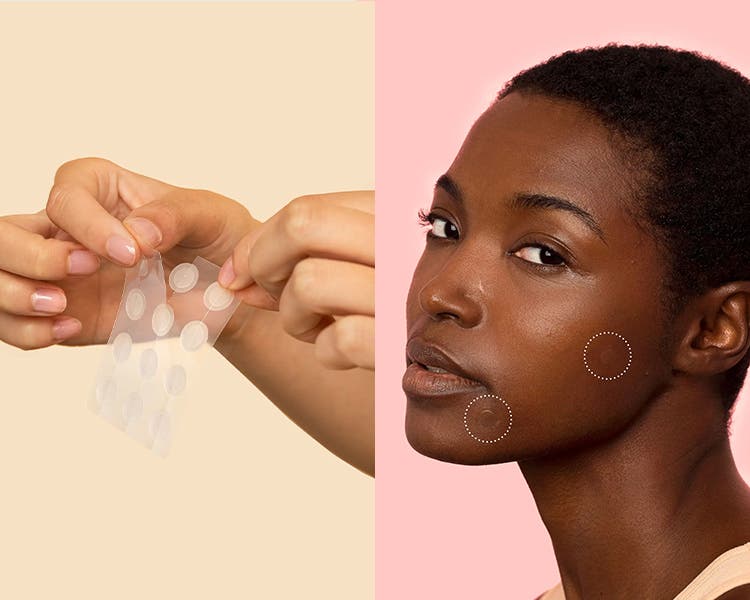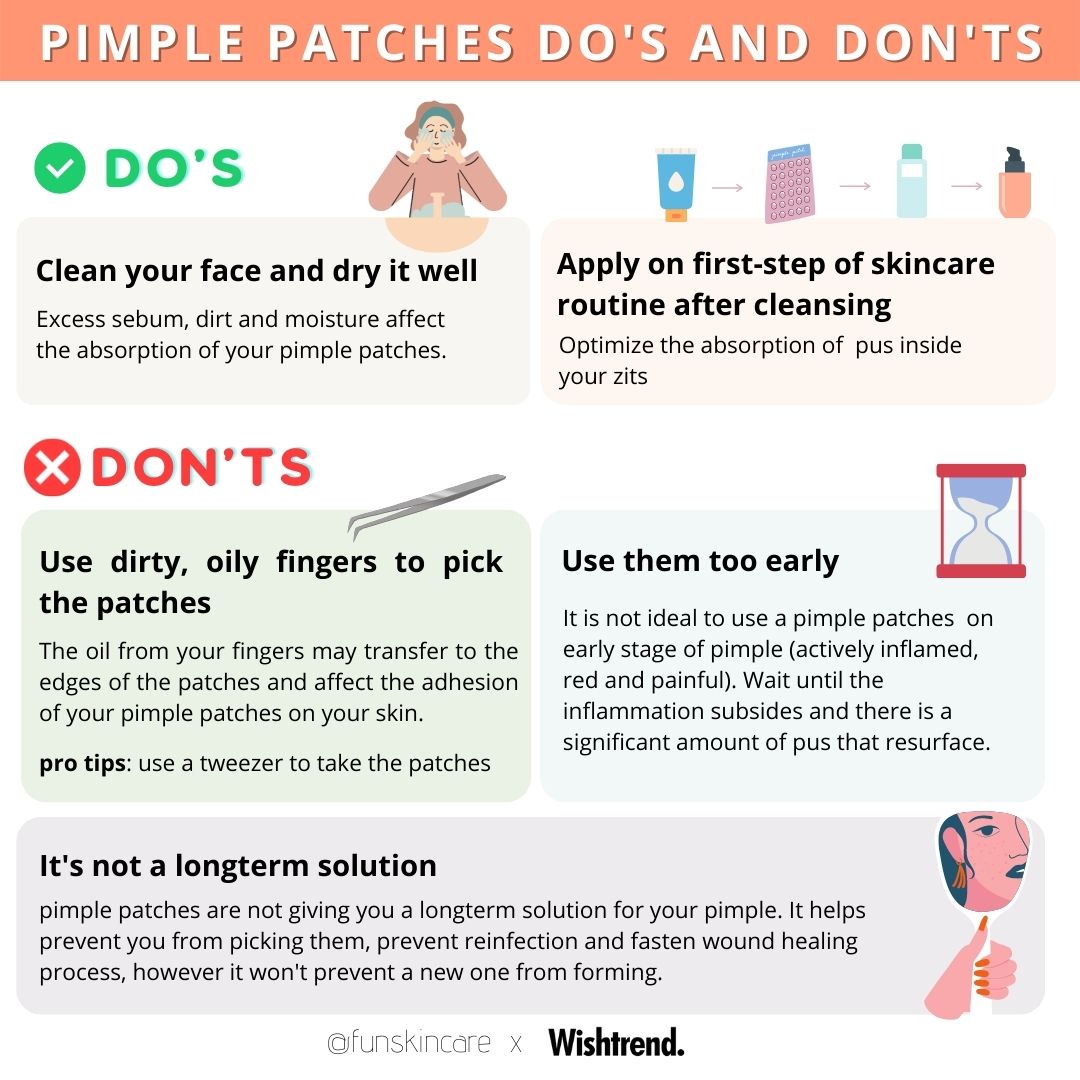Use an acne patch when you notice a pimple forming or after it has come to a head. Apply it to clean, dry skin for the best results.
Dealing with acne can be a frustrating experience, but incorporating acne patches into your skincare routine could be a game-changer. These small, discrete patches are infused with active ingredients that help to heal pimples quickly. They’re designed to create a protective barrier, isolating the blemish from bacteria and preventing you from picking at it, which can reduce healing time and the potential for scarring.
Acne patches are especially useful overnight or throughout the day under makeup, as they are nearly invisible on the skin. They’re a convenient and effective solution for anyone struggling with occasional breakouts or more persistent acne issues. Remember to choose a patch that suits your skin type and the particular stage of your breakout for optimal effectiveness.
Introduction To Acne Patches
Acne can pop up at the most inconvenient times. Whether it’s a big meeting or a social event, a sudden breakout can be a confidence dampener. Enter acne patches, the tiny but mighty solution for those pesky pimples. They target the problem spot-on, providing a quick, effective remedy. Let’s dive into what these patches are and their benefits.
What Are Acne Patches?
Acne patches, also known as pimple patches, are small, round adhesive stickers. You place them directly on a blemish. They are designed to protect the area and speed up healing. The patches are usually transparent or skin-toned for discretion.
Benefits Of Using Acne Patches
- Protects the skin from bacteria and fingers that can cause further inflammation.
- Speeds up healing by maintaining a moist environment.
- Reduces the urge to pick at the acne, preventing scars.
- Absorbs pus and oil, flattening the pimple quickly.
- Contains active ingredients like salicylic acid or tea tree oil to treat acne.
- Discreet and can be worn under makeup or overnight.

Credit: www.nordstrom.com
Identifying The Right Time To Apply Acne Patches
Struggling with acne can be frustrating. Knowing when to use an acne patch can make all the difference. Acne patches, when applied correctly, can help heal blemishes effectively. Let’s explore the best moments to use these skin saviors.
Best Stages Of Acne For Patch Application
Not all acne stages are ideal for patch application. Acne patches work best on certain types of breakouts. Here’s a quick guide:
- Whiteheads: Visible pus indicates it’s time to apply.
- Early-stage pimples: Red and sore spots can benefit from patches.
- Post-pop healing: If you’ve popped a pimple, a patch can protect it from bacteria.
Remember, deep cystic acne might not respond well to patches. Consult a dermatologist for such cases.
Signs That Your Skin Needs An Acne Patch
Look for these signs to know when to reach for an acne patch:
| Sign | Explanation |
|---|---|
| White or Yellow Pus | Patches can absorb this and promote healing. |
| Redness and Inflammation | Patches can deliver active ingredients to reduce these symptoms. |
| Opened Blemish | Use a patch to protect the area from dirt and germs. |
Touching your face often or if the area is prone to friction, like with phone use, consider using a patch. This prevents further irritation and potential scarring.
Types Of Acne Patches
Discovering the right acne patch for your skin can be a game-changer. Acne patches come in various types, each designed to target different aspects of acne treatment. Explore these options to find your perfect match and give your skin the care it deserves.
Hydrocolloid Patches
Hydrocolloid patches are the secret weapon for those pesky pimples. These patches are made from a water-absorbing material. It draws out pus and other impurities. This creates a moist environment that helps heal your skin without drying it out.
- Protects the affected area from bacteria
- Reduces inflammation and redness
- Prevents the urge to pick at blemishes
Medicated Patches
When you need an extra punch, medicated patches step in. These patches contain active ingredients like salicylic acid or tea tree oil. They target acne-causing bacteria and calm inflammation. They are like tiny spot treatments that work while you sleep.
| Ingredient | Benefit |
|---|---|
| Salicylic Acid | Unclogs pores |
| Tea Tree Oil | Antibacterial properties |
| Hydrogen Peroxide | Disinfects the area |
Invisible Patches
Invisible patches are your stealthy solution. They are ultra-thin and can be worn throughout the day. You can even apply makeup over them. They treat your acne discreetly while you carry on with your daily activities.
- Almost invisible on the skin
- Flexible and comfortable to wear
- Continues treatment while you’re on the go

Credit: wishtrend.com
Preparation Steps Before Applying Acne Patches
Before unleashing the healing power of acne patches, proper skin preparation is crucial. Follow these steps to ensure optimal adhesion and effectiveness. Let’s dive into the prep routine for a clearer complexion.
Cleaning the affected areaCleaning The Affected Area
Clean skin is a must before applying an acne patch. Dirt or oil can reduce the patch’s ability to stick. Use a gentle cleanser to avoid irritating the skin. Pat the area with a soft towel instead of rubbing.
- Select a mild cleanser free from oils and fragrances.
- Gently wash the area with lukewarm water.
- Use soft circular motions to avoid aggravating the acne.
Drying The Skin Thoroughly
To ensure the patch’s maximum grip, dry your skin completely. Any moisture can hinder the patch from sealing properly. Let the skin air dry or use a clean, dry cloth to pat the area gently.
| Step | Action |
|---|---|
| 1 | Wait a few minutes after cleaning. |
| 2 | Pat dry with a clean towel. |
| 3 | Avoid touching the area after drying. |
Optimal Placement And Duration
Understanding the Optimal Placement and Duration for acne patches is crucial. This ensures that they work effectively. Knowing where and how long to apply them can make a big difference. Let’s dive into the specifics of applying acne patches correctly.
Where To Place Acne Patches
Acne patches are best used on pimples that have come to a head. Place them directly on the blemish. Make sure your skin is clean and dry before application. The patch should cover the pimple completely. This will protect it from bacteria and help absorb pus and oil.
- Clean area around the pimple.
- Peel off the patch from its film.
- Center it over the pimple.
- Press gently for a few seconds.
How Long To Leave Them On
Acne patches work over a period of hours. They are designed to be worn for an extended time. For best results, leave them on for at least 6 hours. Some patches are made for overnight use. Do not exceed 12 hours to avoid skin irritation.
| Acne Patch Type | Minimum Duration | Maximum Duration |
|---|---|---|
| Daytime | 6 hours | 8 hours |
| Overnight | 6 hours | 12 hours |
Remember to replace the patch if it turns opaque. This means it has absorbed pus and needs a change. Follow the instructions on the package for the best outcome.
:max_bytes(150000):strip_icc()/VW-Health-Pimple-Patches-V2-87587ba0ce434792b8e6ad4ebeb39e1f.jpg)
Credit: www.verywellhealth.com
Aftercare Following Acne Patch Removal
Taking care of your skin after removing an acne patch is crucial. The right aftercare can help heal your skin faster. It may even prevent new pimples from forming. Let’s explore the steps you should take following acne patch removal.
Skin Care Post-patch
Cleanse Gently: Start with a soft cleanse. Use a mild, non-abrasive cleanser to remove any residue.
Hydrate Your Skin: Apply a light, non-comedogenic moisturizer. It helps keep your skin soft.
Protect: If heading outdoors, don’t forget sunscreen. It shields your skin from harmful UV rays.
Observing Changes And Next Steps
Monitor Your Skin: Look for any redness or swelling. It tells you how your skin is healing.
Spot Treatment: If the blemish persists, consider a targeted spot treatment. Choose one that suits your skin type.
Plan Your Routine: Adjust your skin care routine based on how your skin reacts. Your skin’s needs can change over time.
Common Mistakes To Avoid With Acne Patches
Using acne patches seems simple, but common errors can reduce their effectiveness.
Overusing Acne Patches
Acne patches work best when used correctly.
- Do not cover every small spot or blemish with a patch.
- Using too many patches can irritate the skin.
- Apply only on pus-filled pimples.
Stick to using a single patch per blemish and replace it according to the package instructions.
Applying Patches On Unclean Skin
Clean skin is crucial for the patch to work.
- Wash your face with a gentle cleanser.
- Dry your skin completely.
- Apply the acne patch on dry skin.
Dirt or oil under the patch can prevent it from sticking properly and reduce its effectiveness.
Alternatives And Complementary Treatments
Exploring Alternatives and Complementary Treatments for acne can boost your skincare routine. Not all skin types react the same to treatments, making alternatives vital.
Topical Treatments
Aside from acne patches, several topical treatments can help manage breakouts:
- Benzoyl Peroxide: Kills bacteria and removes excess oil.
- Salicylic Acid: Unclogs pores and reduces swelling.
- Tea Tree Oil: A natural option that battles bacteria.
These creams or gels are easy to apply and often available over-the-counter.
Lifestyle Changes For Better Skin Health
Improving your lifestyle can enhance your skin’s health. Simple changes make a big difference:
| Lifestyle Change | Benefits |
|---|---|
| Hydrate More | Keeps skin supple and flushes out toxins. |
| Healthy Diet | Reduces inflammation and supports skin repair. |
| Sleep Well | Allows skin to heal and renew overnight. |
These steps are easy to follow and help your skin look its best.
Frequently Asked Questions
When Should You Put A Pimple Patch On?
Apply a pimple patch after cleansing your skin, preferably at the first sign of a blemish. Use it on a dry area for optimal adhesion.
Do Pimple Patches Work On Unpopped Pimples?
Yes, pimple patches can be effective on unpopped pimples by protecting the area and absorbing pus and oil, aiding in healing.
Is It Better To Leave A Pimple Alone Or Use A Pimple Patch?
It’s generally better to use a pimple patch than to leave a pimple alone. Pimple patches can protect the area and help heal the blemish faster.
Do Pimple Patches Draw Out Pus?
Yes, pimple patches can draw out pus from acne, helping to reduce inflammation and promote healing.
Conclusion
Understanding the right moments to apply an acne patch can significantly improve your skincare routine. As we’ve discussed, these handy blemish-fighters are ideal for isolated pimples, post-extraction care, and overnight healing. Remember, for widespread acne or severe cases, consult a dermatologist.
Embrace clearer skin by using acne patches smartly and say goodbye to unwanted breakouts.

